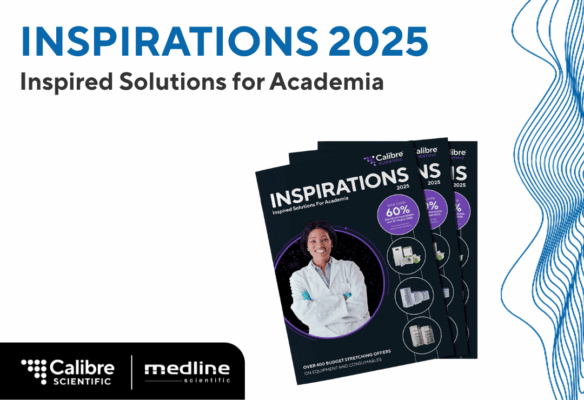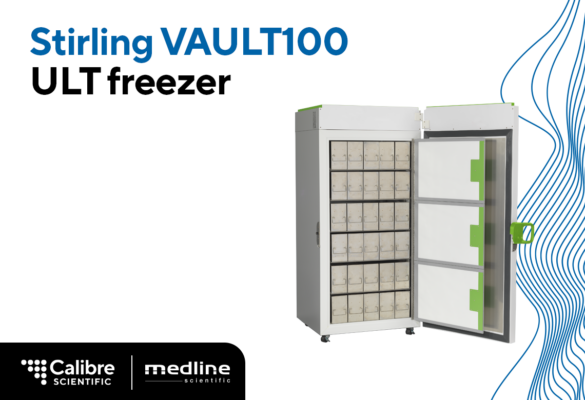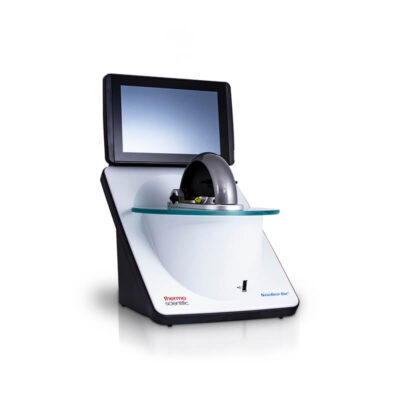How innovative technology delivers efficient and reliable ULT storage to laboratories worldwide
Fridges, freezers and ultra-low temperature (ULT) freezers are a common sight in laboratories across the world, with many scientific organisations having all three running all day, every day, and often with back-up units in place. Since laboratory ULT freezers can consume between 3,900 and 11,100kWh/year of energy1—even more when HVAC costs are considered—you could say that they leave a rather large carbon footprint behind them. And this makes them a sensible place to start for those organisations investigating ways to reduce their energy usage and environmental impact.
Over a decade ago, the team at Stirling Ultracold decided to do something revolutionary… they brought their patented free-piston Stirling engine to a whole new industry!
The Stirling free-piston cooling engine had been successfully tried and tested in aerospace, electronics, energy and other industries for many years. And in 2009, the team built their first compressor-free ULT freezer for the laboratory market. First came the under bench SU105 freezer and the portable ULT25 model; followed by their large capacity upright SU780XLE ULT in 2013.
Where this story gets interesting for the life sciences industry, is when we consider the potential benefits for the organisations that take advantage of this innovative technology. It is well established that laboratories are high energy consumers2 and many are now taking steps to minimise their impact. The ULT freezers from Stirling Ultracold offer scientific organisations a more sustainable alternative to traditional compressor-based freezers.
Taking steps to minimise environmental impact:
At the heart of every Stirling ULT freezer is the Stirling engine. This innovative technology replaces traditional compressor-based cooling and eliminates on-off cycling. Instead, the continuous modulated cooling provided by the Stirling engine is more energy efficient and therefore cheaper to run. In fact, the Stirling SU780XLE 780L upright ULT freezer runs on as little as 6.67kWh/day.
More energy efficient = Lower running costs
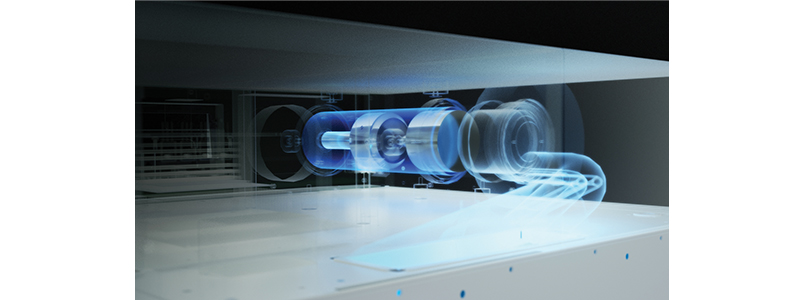
Both the amount and the type of equipment within a laboratory also has a direct impact on how hard a building’s HVAC systems need to work to maintain an appropriate ambient temperature. Compared with traditional compressor-based ULT freezers, the Stirling SU780XLE generates 70–75% less heat which in turn reduces demand on the building’s air conditioning/ventilation systems.
Less heat output = Lower HVAC costs + reduced CO2 footprint
Due to the innovative design of the Stirling engine, organisations are able to make further savings over the life cycle of the freezer. First, the engines contain few moving parts and no oil which results in lower ongoing maintenance requirements and any associated costs.
Few moving parts + no oil = Low maintenance
Secondly, the technology provides very reliable operation over a long life cycle. Therefore, both the upright SU780XLE (780L) and the compact SU105UE (105L) come with an industry-leading warranty: seven years for engine and thermosiphon; two years for parts and labour.* This means that customers benefit from secure sample storage with reduced risk of downtime.
Highly reliable design = Secure storage + less downtime
Seven year warranty = Long life cycle
As well as offering a more energy-efficient solution, the Stirling engine is more space efficient than its compressor system counterparts, which leaves more room for samples! For example, the SU780XLE can store 600 sample boxes in a smaller footprint than any comparable ULT freezer, and it can be configured for up to 700 boxes with a concentrated racking system. As a result, laboratories might be able to purchase fewer freezers to store the same volume of samples and save valuable lab space and budget.
Improved space efficiency = Largest m3 storage capacity per m2 of floor space
In fact, you can fit more samples in each freezer AND more freezers in a given area. How?
A much smaller clearance for door swings coupled with upper-side air venting means that more freezers can be accommodated in a specified area. With the SU780XLE, organisations can create space-efficient, high-density sample storage.
Air vent configuration + smaller door clearance = More freezers per given area
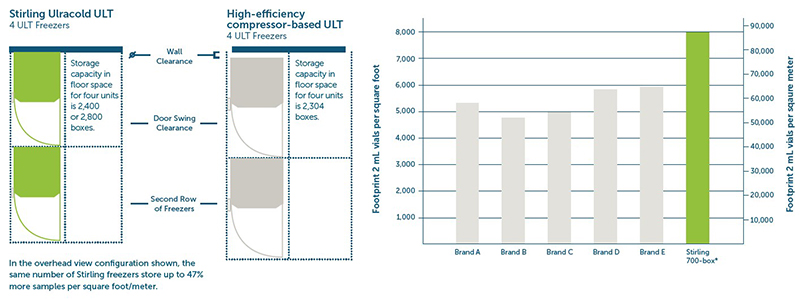
When you put all of this together:
The SU780XLE ULT freezer has the lowest total cost of ownership for any ULT currently available. Furthermore, customers get the industry’s best energy savings in its class and the smallest operating carbon footprint per sample capacity.
In their mission to deliver something different, the Stirling Ultracold team didn’t stop there:
There’s something quite unusual about Stirling’s ULT freezers: they all offer precise temperature storage from -20°C right through to -86°C. This allows far greater flexibility for sample storage and makes them suitable for a broader range of applications, such as storing DNA samples at -20°C to -30°C. Whereas most compressor-based ULTs cannot be set above -50°C, the extended temperature range offered by Stirling units provides the possibility of repurposing units after a project is completed.
Wide set point temperature range = Greater storage flexibility
Since Stirling’s ULT freezers can automatically switch across a wide voltage range of 110 to 240V by simply changing power cords, they can be operated anywhere in the world. This means that no costly electrical modifications are needed to existing infrastructure or voltage boosters. In addition, the portable ULT25NEU (25L) freezer can even run on 12V DC power (with a vehicle adapter) or alternative-energy power sources, such as solar and wind energy.
Flexible power options = Operate anywhere in the world

Initiatives to improve sustainability:
The introduction of the Stirling engine enabled a significant reduction in energy usage and heat output along with a long product life cycle and simplified maintenance. However, the team took several more steps in their journey to create a more sustainable option for laboratories. So, what else did they do?
- Refrigerants: All models use 100% natural refrigerants for reduced climate impact and improved sustainability.
- Insulation: Ecomate® (zero GWP/ODP) foam insulation blowing agent is a more environmentally friendly alternative to more traditional foam insulation that can contain HCFCs and HFCs. Ecomate® is both Kyoto and Montreal compliant.
- Manufacture: Freezers are manufactured in a waste reduction facility that follows basic principles of a zero waste economy.
Almost ten years on from its initial launch into the laboratory, the SU780XLE upright freezer offers:
Lowest cost of ownership for any ULT + smaller carbon footprint = Improved sustainability
Visit our Sustainable Solutions microsite for more information or contact us: enquiries@medlinescientific.co.uk
*Models: SU780XLE and SU105UE have a 2-year parts, and 7-year engine and thermosiphon warranty. Model ULT25NEU has a 1-year warranty.
All images supplied by Stirling Ultracold.
1) Beresini, J., Delaney, P., Paradise, A., & Zeng, K. (2015). Market Assessment of Energy Efficiency Opportunities in Laboratories. Emerging Technologies Program report. https://www.etcc-ca.com/sites/default/files/reports/ceel_market_assessment_et14pge7591.pdf
2) https://www.labnews.co.uk/article/2025394/don_t_let_energy_efficiency_tie_you_in_knots

